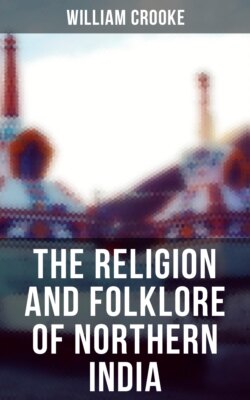Читать книгу The Religion and Folklore of Northern India - William Crooke - Страница 72
На сайте Литреса книга снята с продажи.
The Jungle Mothers.
ОглавлениеTable of Contents
As an instance of another type of Mother-worship we may take Porû Mâî of Nadiya. She is “represented by a little piece of rough black stone painted with red ochre, and placed beneath the boughs of an ancient banyan tree. She is said to have been in the heart of the jungles, with which Nadiya was originally covered, and to have suffered from the fire which Râja Kâsi Nâth’s men lighted to burn down the jungle.”62 She is, in fact, a Mother goddess of the jungle, of whom there are numerous instances. In the North-Western Provinces she is usually known as Banspatî or Bansapatî Mâî (Vanaspatî, “mistress of the wood”). Agni, the fire god, is described in the Rig Veda as “the son of the Vanaspatis,” or the deities of the large, old forest trees.63 Another name for her in the Western Districts is Âsarorî, because her shrine is a pile of pebbles (rorî) in which her votaries have confidence (âsâ) that it will protect them from harm. The shrine of the jungle mother is usually a pile of stones and branches to which every passer-by contributes. When she is displeased she allows a tiger or a leopard to kill her negligent votary. She is the great goddess of the herdsmen and other dwellers in the forest, and they vow to her a cock, a goat, or a young pig if she saves them and their cattle from beasts of prey. Sometimes she is identified with the Churel, more often with a Havva or Bhût, the spirit, usually malignant, of some one who has met untimely death in the jungle. Akin to her is the Ghataut of Mirzapur, who is the deity of dangerous hill passes (ghât) and is worshipped in the same way, and Baghaut, the ghost of a man who was killed by a tiger (bâgh). These all, in the villages along the edge of the jungle, merge in character and function with the divine council, or Deohâr, of the local gods.
